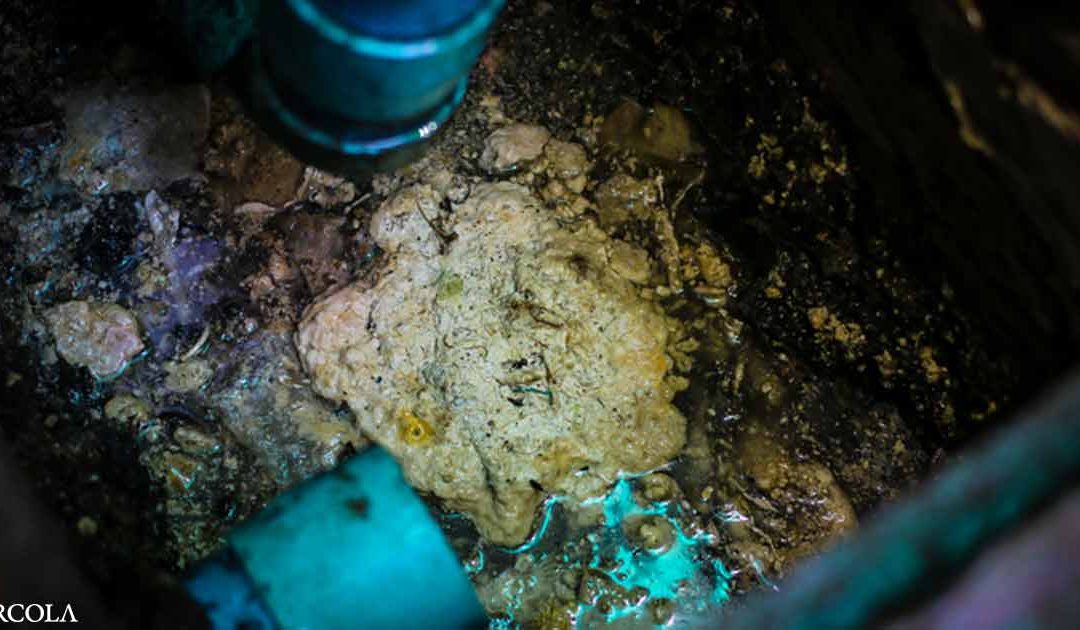In 2008,1 the term “fatberg” was coined to describe large masses of fat, oil and grease (FOG) that clog the sewer system and attract other objects flushed down the toilet.2 However, sewage systems were designed to only handle human waste and toilet paper.
As humans moved from hunters and harvesters to producers and traders, they began settling and populating cities.3 With population density came an increase in the amount of waste products produced and the necessity to dispose of it. The concept of hygiene did not develop until the Roman Empire began building sewage systems in the streets.
They also built latrines where people defecated in a squatting position in public. During the Middle Ages, much of what the Romans had developed was forgotten and only a few cities preserved some of the structures that the Romans had built. By 1830, the stench of human excrement in the city of London became unbearable and was accompanied by cholera epidemics and a high death toll.
After a devastating fire in Hamburg in 1842, a new sewage system was incorporated in the reconstruction that drained sewage into the sea and was cleaned weekly. Other European and U.S. cities followed suit and created similar systems. Eventually, city engineers designed closed systems that use water to transport the excrement.
By 1910, the cholera outbreaks had stopped,4 but a different problem had taken its place with epidemics of typhoid caused by the tainted waters. It was at this point that sanitary engineers began filtering and disinfecting drinking water. Some of these same sewer systems are still in operation throughout the U.S., and some are over 200 years old.5
One example of a sewage system that’s over 100 years old is the District of Columbia’s, which was developed and constructed in the early 1900s. But other such systems abound and are posing challenges to modern-day sewage engineers and city systems.
In Alabama alone, more than 400 systems asked the Alabama Department of Environmental Management for pandemic money to upgrade their systems.6 Montgomery, alone, applied for $225 million for their upgrades. But even upgrading the pipes and sewer system will not remove the fatberg problem.
What Is a Fatberg?
A fatberg develops inside the sewer system when clumps of FOG are joined by other nonbiological waste, most notably baby wipes. According to Newsweek,7 fatbergs are a relatively recent phenomenon and are driven in large part by wet wipes. Although wipes have been available since the 1960s, it wasn’t until they were marketed to adults as a ‘flushable’ alternative to toilet paper that fatbergs began to collect in city sewer systems.
While many of these wipes are labeled “flushable,” they don’t break down in the sewage system. Instead, FOG clings to the wipes and begins to collect other nonbiological waste products such as paper towels, sanitary pads, tampons, condoms and other products. As the fatberg grows, it undergoes a chemical reaction called saponification.8
This breaks down the fat and results in calcification that transforms the block into a hard and relatively immovable mass. Fatbergs collect all kinds of debris. In London, sewage workers have found false teeth, watches and pens.9 Other sewage workers have found planks of wood, tennis balls,10 bones, typewriters and bowling balls.11
Many of the larger objects may have been dumped into the system by lifting manhole covers. What’s in these fatbergs and the color of them will depend on the community where they are formed.12
Utility companies in New York and London have reported that restaurants are likely responsible for a large amount of the FOG flushed into the sewer systems.13 This in turn is exacerbated by a large number of wipes community members flush down the toilet. “It is hard not to think of it as a tangible symbol of the way we live now, the ultimate product of our disposable, out of sight, out of mind culture.” wrote Tim Adams in The Guardian.14
Fatbergs Are Dangerous and Expensive to Clean Up
Newsweek reports that in 2018, “90% of a London fatberg was composed of cooking fat.”15 The thing is, these fatbergs aren’t that easy to clean up: As demonstrated by a130-ton fatberg found in London in 2017, they not only can grow to an alarming size, but can turn into a mass as solid as concrete.
“They’re a particular menace in British cities, where narrow Victorian-era plumbing is easily overwhelmed by blockages and the population far exceeds what the system was built to accommodate,” Newsweek reports. Researchers have also found that fatbergs contain bacteria, including E. coli and listeria.
When fatbergs completely block the sewer lines, sewage backs up into toilets, roads and gardens releasing millions of gallons of water, sewage and bacteria. Matt Rimmer, head of waste networks for Thames Water in London called the cleanup of one fatberg a “total monster … taking a lot of manpower and machinery to remove.”16
In 2017, the city of Baltimore17 also discovered a fatberg brewing under the city streets. The Department of Public Works discovered it was responsible for a dry weather sewer overflow that released 1.2 million gallons of sewage. When they investigated the overflow, they found the 100-year-old, 24-inch-wide pipe was up to 85% clogged, which blocked the flow of sewage.
Clearing these massive blockages in the sewers places a financial burden on a municipality’s utility system.18 New York City spends more than $4.65 million each year and the U.K. spends nearly $130 million clearing hundreds of thousands of fatbergs. These blockages are not limited to largest cities. Fort Wayne, Indiana, which has a population of just 279,228,19 reports spending $500,000 each to clear their sewer lines.
The Des Moines, Iowa, Metropolitan Wastewater Reclamation Authority told Bloomberg they spent more than $100,000 in 2021 for its population of 208,966.20,21 In Charleston, South Carolina, which has only 141,931 citizens, the wastewater district reports 2021 was their worst year with fatbergs. “In response, the city increased its anti-fatberg budget to $360,000 — a 44% increase from the previous year,” Bloomberg said.
To tackle the cleanout of a fatberg, sewage workers dress in gas masks and protective suits. The masses of fat and wipes are known for the smell and noxious gasses. Added to this, the temperature underground is often stifling hot, which makes the work uncomfortable and dangerous.
Pandemic Wipes Exacerbate the Problem
Kimberly Worsham is the founder of Facilitated Learning for Universal Sanitation and Hygiene (FLUSH). The company’s goal is to change how the world does sanitation. She talked about the problem with wet wipes in the sewer system, saying:22
“We started seeing the instances of these larger and sometimes mega fatbergs popping up in big cities like London around the time the popularity of adults using wet wipes really started to boom, which was about a decade ago. Imagine a bunch of fat-soaked wet wipes in a sewer about 2 feet wide — they’re going to get together and clump up.”
While the problem may have begun nearly a decade ago, it was severely exacerbated during the pandemic. Larry Hare, manager at the wastewater reclamation facility in Des Moines, told Bloomberg he’s seeing 50% greater sewer backups in 2020 than he had in past years.23 The problem has been the advertised ‘flushable’ wipes that consumers are using to clean surfaces throughout their homes and businesses.
With sales having surged 75% during the pandemic, sanitary wipes for use in cleaning household items have also become a problem.24 Because the clogs don’t usually happen at the source — where people flush them — Gary Hawkins, a professor in water resource management at the University of Georgia, believes that it’s a problem of “out of sight, out of mind type things.”
Although city engineers have been warning of the danger involved when flushing wipes and paper towels, it appears that people have not heard. While there has been greater use of wipes to disinfect surfaces and body parts during the pandemic, there’s also no reason those wipes can’t be thrown in the garbage.
As the number of fatbergs continues to grow across the world, city engineers and city officials around the world are once again asking people not to flush paper towels, wipes, condoms or anything other than toilet paper and human waste down the toilet.25
Fatbergs: The Result of Bad Habits
Tampa, Florida, has also experienced a growing number of fatbergs during the pandemic. The city reportedly has spent millions of dollars to repair and reconfigure three pump stations after pipes clogged from consumers switching from toilet paper to wipes.26
As the number of fatbergs in London has grown, the Thames Water London utility company evaluated fast-food restaurants to determine how many had adequate grease traps that would stop fat, oil and grease from entering the sewers. Interestingly, they found that 9 out of 10 fast-food restaurants were dumping more FOG down the drain than they should.27
The term “fatberg” first appeared in a story published in the Birmingham Post in 2008 in which the journalist wrote, “particularly memorable are the large, rock-like lumps of cooking fat [Alistair] Grant calls ‘fatbergs.’”28 Historically, fatbergs are nothing new. According to Worsham:
“Fatbergs have been around since as long as humans had sewers — at least since the Roman Empire had its Cloaca Maxima. We have evidence that Roman slaves would have to go pull out the stuck fatty bits from the sewers.
Fatbergs were actually the reason a guy developed the grease trap in the 1880s because he was rightfully sure that fat would destroy the sewer systems eventually. But most fatbergs were relatively small compared to the ones we see nowadays — the magnitude has just increased a ton in the last decade or two.”
In an effort to help head off the flushing of fatberg-causing waste into its sewer systems, one British organization launched a month-long annual campaign in 2019 called Unblocktober.29 The goal is to improve attention on the problems that happen when plastics and other products are flushed through the sewer system.
According to Britain’s KentLive, more than 50 organizations had officially partnered with the campaign in 2020. Naomi Wright from Unblocktober spoke with KentLive, saying:30
“The coronavirus crisis has taken a terrible toll on communities around the world, and unfortunately that damage has reached our sewage networks and rivers, lakes and seas too.
With more people at home during the global lockdown, ‘coronavirus fatbergs’ have been forming at staggering rates across the world as a result of ‘unflushable’ items and substances being put down our drain on a much larger scale …”
How Big Is Big?
Behind all these fatbergs or, rather, under the streets where the sewer lines lie, workers have come face to face with some rather large fatbergs. The Tampa Bay Times called the 108 cubic yards of waste found at Sulphur Springs Pump Station “pipe busting.”31 Yet, larger cities are reporting much larger masses and in London, one fatberg did rupture the sewer pipes.
According to The Guardian,32 the fatberg that broke the sewer pipes in Chelsea, West London, was 40 meters (131 feet) long and approximately 10 tonnes (22,046 pounds). Repairs were expected to take two months and cost £400,000 ($502,000). Thames Water utility company reported to The Guardian in 2015 they had dealt with 200,000 blockages since 2010 and 18,000 homes had been flooded with sewer water.33
Another fatberg found in Kensington was reportedly 15 tonnes (33,069 pounds) and 80 meters (262 feet) long, which took sewer workers four days to clear.34 After residents reported having trouble flushing their toilets, workers found 95% of the 2.4-meter (7.8 feet) diameter sewer pipe was blocked. It required three weeks of work with high-powered jets to clear this fatberg.
A spokesperson from Thames water called this monstrosity “a heaving, sick smelling, rotting mass of filth and feces. It hits the back of your throat, it’s gross.”35 The largest fatberg was unearthed in White chapel, East London, in September 2017, sparking public fascination with the phenomenon.36
After a slice of this one was put on display in the Museum of London, there was a “marked increase in attendance.”37 To address the 117 tonnes (257,941 pounds) of fatberg under the streets of London, Thames Water Utilities System had an eight-person crew working seven days a week transporting 20 to 30 tons of the fatberg off-site for recycling each day.
To put that into perspective, this particular fatberg weighed nearly as much as a blue whale and was twice the size of the playing field at London’s Wembley Stadium.38 Once the fatberg was removed, it was recycled into 2,700 gallons of biodiesel fuel.39
What You Can Do to Protect Your City Sewer System
Consumers can take several small steps that will make a large impact on the sewer system in their city. These fatbergs place a significant drain on taxpayer dollars and place sewer workers at risk of battling the foul-smelling and bacteria-ridden masses.
Avoid flushing anything down the toilet that isn’t human waste or toilet paper. Everything else should go into the garbage. This includes fat, oil, grease, wipes of any nature, feminine hygiene products, condoms and paper towels.
If you enjoy using ‘flushable’ wipes, consider getting a bidet that does a more thorough job using just warm water. Consumers and businesses should install grease traps that reduce the amount of fat and oil that goes down the drain. These are installed below the sink and require regular maintenance to clean.
Consider keeping a grease can where any fat or cooking oil can be dumped and then placed in the garbage. Pans with a little oil clean nicely with a paper towel that can easily be dumped into the garbage.











